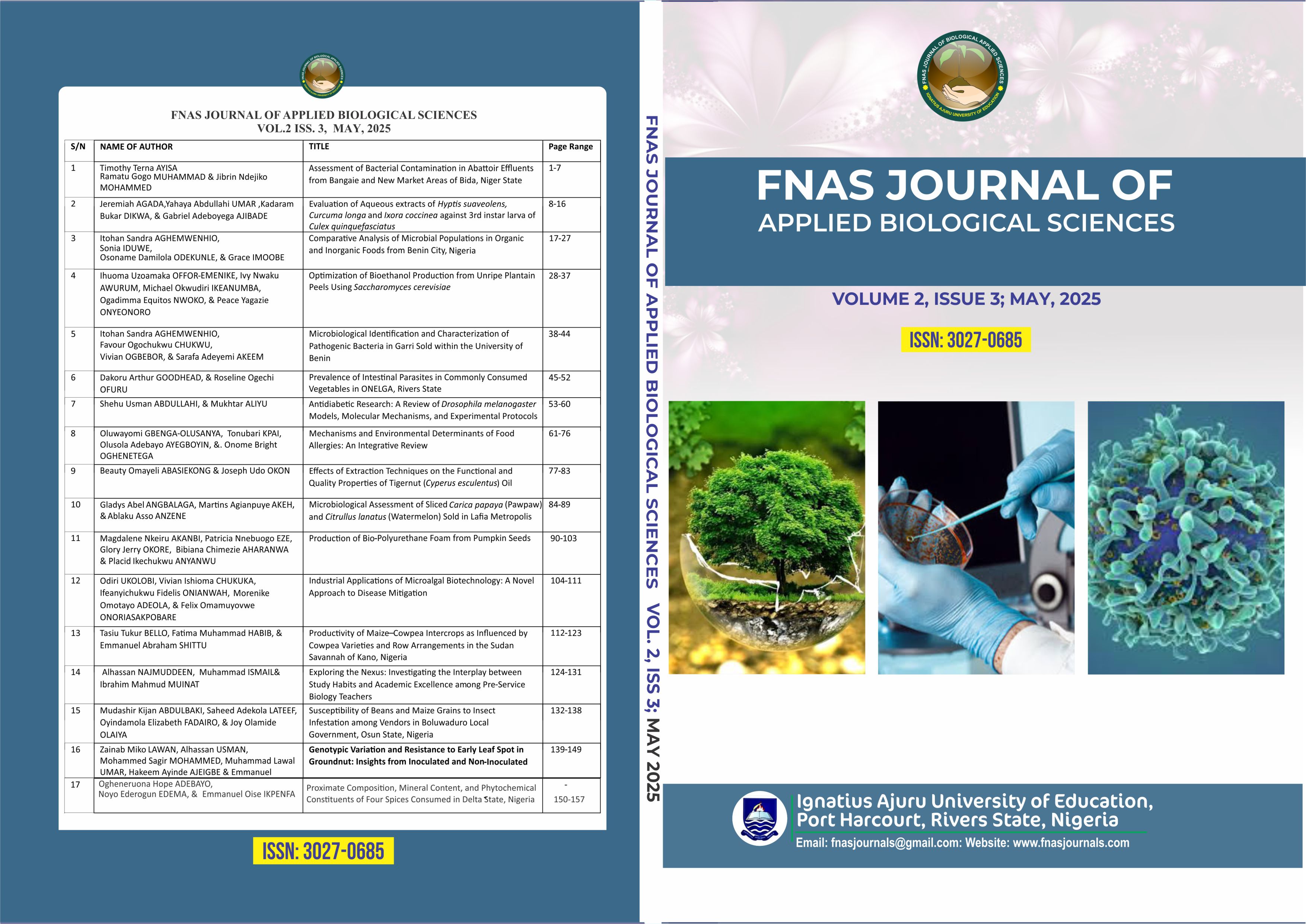Optimization of Bioethanol Production from Unripe Plantain Peels Using Saccharomyces cerevisiae
DOI:
https://doi.org/10.63561/jabs.v2i3.930Keywords:
Unripe plantain peels, Bioethanol, Brix, Optimization, Response Surface MethodologyAbstract
This study investigated the production of bioethanol from unripe plantain peels in an optimized condition. Optimization of production medium maximises metabolite yield. Reliance on food crops is reduced when agricultural waste products are used to produce bioethanol. The capacity of Saccharomyces cerevisiae to ferment wort derived from unripe plantain peels, an agricultural waste, in optimized conditions to produce bioethanol, was studied. A box-behnken design of five factors (substrate weight, temperature, inoculum size, pH, incubation time) and three levels was adopted to improve production efficiency. The substrate (unripe plantain peels) was subjected to physical and biological pretreatments to obtain simple sugars. Cellulase enzyme was used to breakdown the substrate to simpler sugars. Alcoholic fermentation was done using S. cerevisiae for six days. Brix content was measured before and during the fermentation process, as well as alcohol content after fermentation. Response surface plots of the factors were plotted. The results showed that brix value ranged from 0.5 oBx to 2.0 oBx while bioethanol production ranged from 0.2g/l to 1.1g/l. At optimal conditions of pH 6, temperature of 40oC, inoculum size of 5, substrate weight of 20g and fermentation time of 75h, predicted ethanol yield will be 1.3g/l with maximum concentration of brix as 2.2 oBx. 1.3g/l of bioethanol was realized with optimization of the fermentation medium. The peel of unripe plantains is a good substrate for the synthesis of bioethanol.
References
Abouzeid, M.M.,& Reddy, A. (1986). Direct fermentation of potato starch to ethanol by co cultures of Aspergillus niger and Saccharomyces cerevisiae. Journal of Applied Environmental Microbiology, 52: 1055-1059. DOI: https://doi.org/10.1128/aem.52.5.1055-1059.1986
Adeboye, P. T., Ogunlaja, O. O., & Ajani, A. A. (2023). Optimization of fermentation parameters for enhanced bioethanol production from agricultural residues. Energy Reports, 9: 2345-2358.
Adeeyo, O. A., Akinlabi, A. K., & Ojumu, T. V. (2015). Potential of Agro-Wastes as Feedstocks for Bioethanol Production. Renewable and Sustainable Energy Reviews, 44: 626-637.
Akinwunmi, O. A. (2022). Sucrase inhibitory Activities of Ethanol Extract of Unripe peels of Musa Paradisica Linn and its Chemical Constituents. Tropical Journal of Natural Product Research, 6(9): 1474-1480. DOI: https://doi.org/10.26538/tjnpr/v6i9.23
Akinyemi, O. O., Bamidele, F. S., & Shittu, O. B. (2022). Valorization of plantain peels: A promising substrate for bioethanol production. Renewable Energy Research Journal, 15(2): 88-96.
Alabi, K. M., Akindele, M. A., & Bello, T. K. (2024). Application of RSM and ANN in bioethanol production optimization: A review. Industrial Crops and Products, 210: 115012.
AOAC, (2000). Official Methods of Analysis (15th edn), Association of Official Analytical Chemists, Washington, DC.
Braide, W., Kanu, I.A., Oranusi, U.S., & Adeleye, S.A. (2016). Production of bioethanol from agricultural waste. Journal of Fundamental and Applied Science, 8(2): 372-386. DOI: https://doi.org/10.4314/jfas.v8i2.14
Chandel, A. K., Silva, S. S. & Singh, O. V. (2012). Detoxification of Lignocellulosic Hydrolysates for Improved Bioethanol Production. Biofuel Production - Recent Developments and Prospects, InTech.
Cheng, H., Liu, Y., & Zhang, X. (2023). Recent developments in yeast fermentation technologies for second-generation bioethanol production. Biotechnology Advances, 62: 108034.
Ganigue, R., Sanchez-Prieto, M., & Lopez-Mesas, M. (2016). Optimization of bioethanol production from glucose fermentation: Impact of pH and temperature. Journal of Chemical Technology & Biotechnology, 91(8), 2245–2253.
Haynes, W.M. (2011). CRC Handbook of Chemistry and Physics. 92nd edition. CRC Press, Boca Raton, Florida, U.S.A., pp: 246-258.
Irfan, T, Katherine, L, Bialka, A.D., & Mustafa, K. (2010). Ethanol production from carob extract by using Saccharomyces cerevisiae. Bioresoure Technology, 101: 5290-5296. DOI: https://doi.org/10.1016/j.biortech.2010.01.146
Khan, M.I., Lee, M.G., Shin, J.H., & Kim, J.D. (2017). Pretreatment and optimization of the biomass of Microcystis aeruginosa for efficient bioethanol production. AMB Express, 7- 19. DOI: https://doi.org/10.1186/s13568-016-0320-y
Kumar, P., Barrett, D. M., Delwiche, M. J., & Stroeve, P. (2009). Methods for Pretreatment of Lignocellulosic Biomass for Efficient Hydrolysis and Biofuel Production. Industrial & Engineering Chemistry Research, 48(8): 3713–3729. DOI: https://doi.org/10.1021/ie801542g
Laopaiboon, L., Thanonkeo, P., Jaisil, P., & Laopaiboon, P. (2007). Ethanol production from sweet sorghum juice in batch and fed-batch fermentations by Saccharomyces cerevisiae. World Journal of Microbiology and Biotechnology, 23(10), 1497–1501. DOI: https://doi.org/10.1007/s11274-007-9383-x
Manikandan, K., Karuppaiya, M. & Viruthagiri T. (2006). Alcohol fuels-Current Technologies and future prospects India. Pp 1-13.
Martín, C., Galbe, M., Wahlbom, C.F., Hahn-Hägerdal, B., & Jönsson, L.J. (2002). Ethanol production from enzymatic hydrolysis of sugarcane bagasse using recombinant xylose- utilizing Saccharomyces cerevisiae. Enzyme and Microbial Technology, 31: 274-282. Nadir N., Mel, M., Karim, M.I.A., & Yunus, R.M. (2009). Comparison of sweet sorghum and cassava for ethanol production by using Sacchaomyces cerevisiae. Journal of Applied Sciences, 9 (17): 3068-3073. DOI: https://doi.org/10.1016/S0141-0229(02)00112-6
Nagodawithana, T.W., Castellano, C. & Steinkraus, K.H. (1974). Effect of dissolved oxygen, temperature, initial cell count and sugar concentration on the viability of Saccharomyces cerevisiae in rapid fermentation. Journal of Applied Microbiology, 28: 293-391. DOI: https://doi.org/10.1128/am.28.3.383-391.1974
Offor-Emenike, I.U., Ibekwe, V., Akujobi, C., & Braide, W. (2020). Brix Production from Cassava Peels and Optimization of Bioethanol Synthesis using Saccharomyces cerevisiae. Journal of Food and Environment Safety, 14(4): 307-315.
Ogbuagu, M. N., & Okonko, I. O. (2024). Efficient pretreatment strategies for bioethanol productionfrom lignocellulosic biomass. Biomass Conversion and Biorefinery, 14(1):111-123.
Remi, O. (2023). Nutritional Composition of Processed and Unprocessed Samples of Unripe Plantain (Musa Paradisica). Journal of Advanced Education and Sciences, 3(1): 75-81.
Scholar, J., & Benedikte, W. (1999). Practical Fermentation. A Guide for Schools and Colleges. The society for general Microbiology, www.ncbe.reading.ac.uk.
Sornvoraweat, B. & Kitpreechavanich, V. (2008). Production of Ethanol from Agricultural Waste using Cellulase from Newly Isolated Trichoderma sp. KMITL Science and Technology Journal, 8(1): 8-13.
Suh, S., Zhang, N., Nguyen, N., Gross, S., & Blackwell, M. (2007). Mycology lab. Louisiana State University, pp: 34.
Sun, Y., & Cheng, J. (2002). Hydrolysis of Lignocellulosic Materials for Ethanol Production: A Review. Bioresource Technology, 83(1):1-11. DOI: https://doi.org/10.1016/S0960-8524(01)00212-7
Yu, Z. & Zhang, H. (2004). Ethanol fermentation of acid-hydrolyzed cellulosic pryolysate with Saccharomyces cerevisiae. Journal of Bioresource Technology, 93: 199-204. DOI: https://doi.org/10.1016/j.biortech.2003.09.016
Zabed, H., Faruq, G., & Sahu, J.N. (2014). Bioethanol production from fermentable sugar juice. Science World Journal, 5: 1-11. DOI: https://doi.org/10.1155/2014/957102





